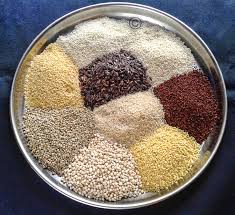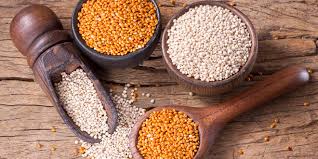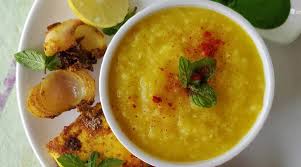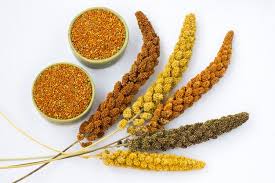Millets Nutritional profile

Millet is a cereal grain that belongs to the Poaceae family, commonly known as the grass family.
It’s widely consumed in developing countries throughout Africa and Asia. While it may look like a seed, millet’s nutritional profile is similar to that of sorghum and other cereals.
Millet has gained popularity in the West because it’s gluten-free and boasts high protein, fiber, and antioxidant contents.
This article reviews everything you need to know about millet, including its nutrients, benefits, and downsides.
Attributes and types of millet
Millet is a small, round whole grain grown in India, Nigeria, and other Asian and African countries. Considered an ancient grain, it’s used both for human consumption and livestock and bird feed
It has multiple advantages over other crops, including drought and pest resistance. It’s also able to survive in harsh environments and less fertile soil. These benefits stem from its genetic composition and physical structure — for example, its small size and hardness.
Although all millet varieties belong to the Poaceae family, they differ in color, appearance, and species.
This crop is also divided into two categories — major and minor millets, with major millets being the most popular or commonly cultivated varieties.
Major millets include:
- pearl (sajjalu)
- foxtail (korralu)
- proso (or white)(varigalu)
- finger (or ragulu)
Minor millets include:
- Kodo (arikalu)
- barnyard(Udalu)
- little (samalu)
- Guinea
- browntop (andu korralu)
- fonio
- adlay (or Job’s tears)
Pearl millet is the most widely produced variety intended for human consumption. Still, all types are renowned for their high nutritional value and health benefits.
SUMMARY
Millet is a small cereal grain that belongs to the grass family. Resilient in harsh environments, it’s commonly cultivated in Asian and African countries.
Nutritional profile
Like most cereals, millet is a starchy grain — meaning that it’s rich in carbs. Notably, it also packs several vitamins and minerals.
One cup (174 grams) of cooked millet packs:
- Calories: 207
- Carbs: 41 grams
- Fiber: 2.2 grams
- Protein: 6 grams
- Fat: 1.7 grams
- Phosphorus: 25% of the Daily Value (DV)
- Magnesium: 19% of the DV
- Folate: 8% of the DV
- Iron: 6% of the DV
Millet provides more essential amino acids than most other cereals. These compounds are the building blocks of protein
What’s more, finger millet boasts the highest calcium content of all cereal grains, providing 13% of the DV per 1 cooked cup (100 grams).
Calcium is necessary to ensure bone health, blood vessel and muscular contractions, and proper nerve function.
SUMMARY
Millet is a starchy, protein-rich grain. It provides plenty of phosphorus and magnesium — and finger millet packs more calcium than any other cereal.
Benefits of millet
Millet is rich in nutrients and plant compounds. Therefore, it may offer multiple health benefits.

Rich in antioxidants
Millet is rich in phenolic compounds, especially ferulic acid and catechins. These molecules act as antioxidants to protect your body from harmful oxidative stress.
Studies in mice link ferulic acid to rapid wound healing, skin protection, and anti-inflammatory.
Meanwhile, catechins bind to heavy metals in your bloodstream to prevent metal poisoning .
While all millet varieties contain antioxidants, those with a darker color — such as finger, proso, and foxtail millet — have more than their white or yellow counterparts.
May help control blood sugar levels
Millet is rich in fiber and non-starchy polysaccharides, two types of undigestible carbs that helpcontrol blood sugar levels.
This cereal also has a low glycemic index (GI), meaning that it’s unlikely to spike your blood sugar levels.
Thus, millets are considered an ideal grain for people with diabetes.
For instance, a study in 105 people with type 2 diabetes determined that replacing a rice-based breakfast with a millet-based one lowered blood sugar levels after the meal.
A 12-week study in 64 people with prediabetes gave similar results. After eating 1/3 cup (50 grams) of foxtail millet per day, they experienced a slight reduction in fasting and post-meal blood sugar levels, as well as a decrease in insulin resistance.
Insulin resistance is a marker for type 2 diabetes. It occurs when your body stops responding to the hormone insulin, which helps regulate blood sugar.
What’s more, in a 6-week study in rats with diabetes, a diet containing 20% finger millet led to lower fasting blood sugar levels and a drop in triglyceride and cholesterol levels.
May help lower cholesterol

Millet contains soluble fiber, which produces a viscous substance in your gut. In turn, this traps fats and helps reduce cholesterol levels.
One study in 24 rats found that those fed foxtail and proso millet had significantly reduced triglyceride levels, compared with the control group.
Additionally, millet protein may help lower cholesterol.
A study in mice with type 2 diabetes fed them a high fat diet with millet protein concentrate. This led to a decrease in triglyceride levels and significant increase in adiponectin and HDL (good) cholesterol levels, compared with the control group.
Adiponectin is a hormone with an anti-inflammatory effect that supports heart health and stimulates fatty acid oxidation. Its levels are usually lower in people with obesity and type 2 diabetes.
Fits a gluten-free diet

Millet is a gluten-free grain, making it a viable choice for people with celiac disease or those following a gluten-free diet.
Gluten is a protein that occurs naturally in grains like wheat, barley, and rye. People with celiac disease or gluten intolerance must avoid it because it triggers harmful digestive symptoms, such as diarrhea and nutrient malabsorption.
When shopping for millet, you should still look for a label that certifies it gluten-free to ensure it hasn’t been contaminated with any gluten-containing ingredients.
Potential downsides
Despite millet’s multiple health benefits, it also contains antinutrients — compounds that block or reduce your body’s absorption of other nutrients and may lead to deficiencies.
One of these compounds — phytic acid — interferes with potassium, calcium, iron, zinc, and magnesium uptake. However, a person with a balanced diet isn’t likely to experience adverse effects.
Other antinutrients called goitrogenic polyphenols may impair thyroid function, causing goiter — an enlargement of your thyroid gland that results in neck swelling.
Nevertheless, this effect is associated only with excess polyphenol intake.
For example, one study determined that goiter was significantly more prevalent when millet provided 74% of a person’s daily calories, compared with only 37% of their daily calories.
Furthermore, you can lower millet’s antinutrient content significantly by soaking it overnight at room temperature, then draining and rinsing it before cooking.
Plus, sprouting reduces antinutrient content. Certain health food stores sell sprouted millet, though you can also germinate it on your own. To do so, place soaked millet in a glass jar and cover it with a cloth that’s secured with a rubber band.
Turn the jar upside down, rinsing and draining the millet every 8–12 hours. You’ll notice small sprouts beginning to form after 2–3 days. Drain the sprouts and enjoy them right away.
SUMMARY
Antinutrients in millet block your body’s absorption of certain minerals, though this is unlikely to affect you if you consume a balanced diet. Soaking and sprouting may reduce this grain’s antinutrient levels.
How to prepare and eat millet

Millet is a versatile ingredient that makes a good rice replacement when cooked whole.
To prepare it, just add 2 cups (480 mL) of water or broth per 1 cup (174 grams) of raw millet. Bring it to a boil, then simmer it for 20 minutes.
Remember to soak it overnight before cooking to lower its antinutrient content. You may also toast it in a pan before cooking to enhance its nutty taste.
Millet is also sold as a flour.
In fact, research suggests that making baked goods with millet flour significantly enhances their nutritional profile by increasing their antioxidant content.
Additionally, this grain is processed to make snacks, pasta, and nondairy probiotic beverages. In fact, fermented millet acts as a natural probiotic by providing live microorganisms that benefit your health.
You can enjoy millet as a breakfast porridge, side dish, salad add-in, or cookie or cake ingredient.
Shop for millet or millet flour online.
SUMMARY
Millet is not only available as a whole grain but also a flour. You can use it in a variety of dishes, including porridge, salad, and cookies.
The bottom line
Millet is a whole grain that’s packed with protein, antioxidants, and nutrients.
It may have numerous health benefits, such as helping lower your blood sugar and cholesterol levels. Plus, it’s gluten-free, making it an excellent choice for people who have celiac disease or follow a gluten-free diet.
Its nutty taste and versatility make it well worth trying.
